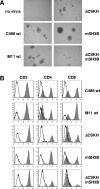Growth transformation of human T cells by herpesvirus saimiri requires multiple Tip-Lck interaction motifs
- PMID: 17005671
- PMCID: PMC1617286
- DOI: 10.1128/JVI.01112-06
Growth transformation of human T cells by herpesvirus saimiri requires multiple Tip-Lck interaction motifs
Abstract
Lymphoma induction and T-cell transformation by herpesvirus saimiri strain C488 depends on two viral oncoproteins, StpC and Tip. The major interaction partner of Tip is the protein tyrosine kinase Lck, a key regulator of T-cell activation. The Lck binding domain (LBD) of Tip comprises two interaction motifs, a proline-rich SH3 domain-binding sequence (SH3B) and a region with homology to the C terminus of Src family kinase domains (CSKH). In addition, biophysical binding analyses with purified Lck-SH2 domain suggest the phosphorylated tyrosine residue 127 of Tip (pY127) as a potential third Lck interaction site. Here, we addressed the relevance of the individual binding motifs, SH3B, CSKH, and pY127, for Tip-Lck interaction and for human T-cell transformation. Both motifs within the LBD displayed Lck binding activities and cooperated to achieve a highly efficient interaction, while pY127, the major tyrosine phosphorylation site of Tip, did not enhance Lck binding in T cells. Herpesvirus saimiri strain C488 recombinants lacking one or both LBD motifs of Tip lost their transforming potential on human cord blood lymphocytes. Recombinant virus expressing Tip with a mutation at position Y127 was still able to transform human T lymphocytes but, in contrast to wild-type virus, was strictly dependent on exogenous interleukin-2. Thus, the strong Lck binding mediated by cooperation of both LBD motifs was essential for the transformation of human T cells by herpesvirus saimiri C488. The major tyrosine phosphorylation site Y127 of Tip was particularly required for transformation in the absence of exogenous interleukin-2, suggesting its involvement in cytokine signaling pathways.
Figures







Similar articles
-
Activation of the Lck tyrosine protein kinase by the Herpesvirus saimiri tip protein involves two binding interactions.Virology. 2000 Oct 25;276(2):339-48. doi: 10.1006/viro.2000.0570. Virology. 2000. PMID: 11040125
-
Characterization of Lck-binding elements in the herpesviral regulatory Tip protein.Biochemistry. 2004 Nov 30;43(47):14932-9. doi: 10.1021/bi0485068. Biochemistry. 2004. PMID: 15554700
-
T-cell growth transformation by herpesvirus saimiri is independent of STAT3 activation.J Virol. 2005 May;79(9):5713-20. doi: 10.1128/JVI.79.9.5713-5720.2005. J Virol. 2005. PMID: 15827186 Free PMC article.
-
Herpesvirus saimiri.Philos Trans R Soc Lond B Biol Sci. 2001 Apr 29;356(1408):545-67. doi: 10.1098/rstb.2000.0780. Philos Trans R Soc Lond B Biol Sci. 2001. PMID: 11313011 Free PMC article. Review.
-
Mechanisms of cell transformation by Herpesvirus saimiri.Anticancer Res. 1999 Mar-Apr;19(2A):973-83. Anticancer Res. 1999. PMID: 10368641 Review.
Cited by
-
Efficient generation of human natural killer cell lines by viral transformation.Leukemia. 2014 Jan;28(1):192-5. doi: 10.1038/leu.2013.188. Epub 2013 Jun 21. Leukemia. 2014. PMID: 23787393 No abstract available.
-
A molecular model for the differential activation of STAT3 and STAT6 by the herpesviral oncoprotein tip.PLoS One. 2012;7(4):e34306. doi: 10.1371/journal.pone.0034306. Epub 2012 Apr 3. PLoS One. 2012. PMID: 22509288 Free PMC article.
-
Activation of noncanonical NF-kappaB signaling by the oncoprotein Tio.J Biol Chem. 2010 May 28;285(22):16495-503. doi: 10.1074/jbc.M110.102848. Epub 2010 Mar 30. J Biol Chem. 2010. PMID: 20353939 Free PMC article.
-
Actin-dependent activation of serum response factor in T cells by the viral oncoprotein tip.Cell Commun Signal. 2012 Mar 3;10(1):5. doi: 10.1186/1478-811X-10-5. Cell Commun Signal. 2012. PMID: 22385615 Free PMC article.
-
Inhibition of retromer activity by herpesvirus saimiri tip leads to CD4 downregulation and efficient T cell transformation.J Virol. 2011 Oct;85(20):10627-38. doi: 10.1128/JVI.00757-11. Epub 2011 Aug 17. J Virol. 2011. PMID: 21849449 Free PMC article.
References
-
- Bauer, F., E. Hofinger, S. Hoffmann, P. Rösch, K. Schweimer, and H. Sticht. 2004. Characterization of Lck-binding elements in the herpesviral regulatory Tip protein. Biochemistry 43:14932-14939. - PubMed
Publication types
MeSH terms
Substances
LinkOut - more resources
Full Text Sources
Molecular Biology Databases
Miscellaneous

